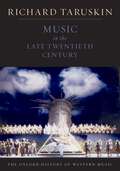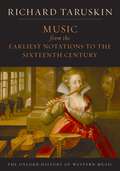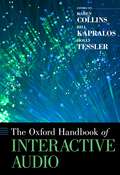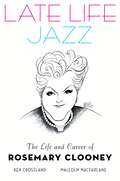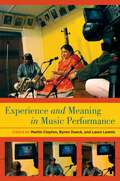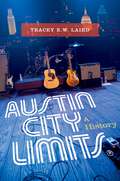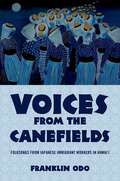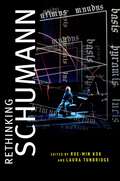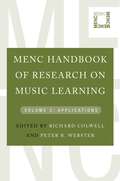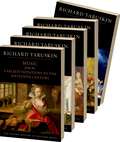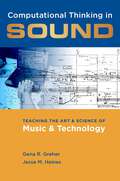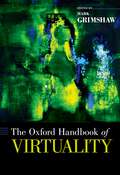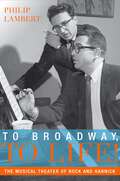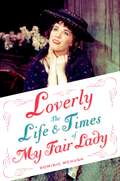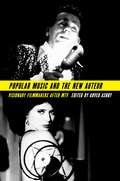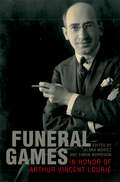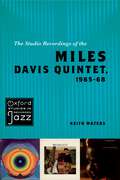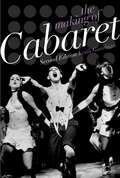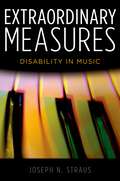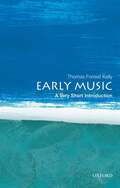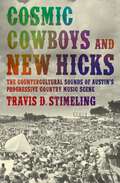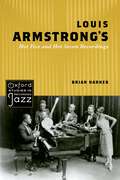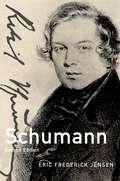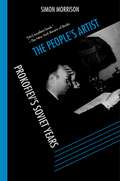- Table View
- List View
Music in the Late Twentieth Century: The Oxford History of Western Music
by Richard TaruskinThe universally acclaimed and award-winning Oxford History of Western Music is the eminent musicologist Richard Taruskin's provocative, erudite telling of the story of Western music from its earliest days to the present. Each book in this superlative five-volume set illuminates-through a representative sampling of masterworks-the themes, styles, and currents that give shape and direction to a significant period in the history of Western music. Music in the Late Twentieth Century is the final installment of the set, covering the years from the end of World War II to the present. In these pages, Taruskin illuminates the great compositions of recent times, offering insightful analyses of works by Aaron Copland, John Cage, Milton Babbitt, Benjamin Britten, Steve Reich, and Philip Glass, among many others. He also looks at the impact of electronic music and computers, the rise of pop music and rock 'n' roll, the advent of postmodernism, and the contemporary music of Laurie Anderson, John Zorn, and John Adams. Laced with brilliant observations, memorable musical analysis, and a panoramic sense of the interactions between history, culture, politics, art, literature, religion, and music, this book will be essential reading for anyone who wishes to understand this rich and diverse period.
Music in the Late Twentieth Century: The Oxford History of Western Music
by Richard TaruskinThe universally acclaimed and award-winning Oxford History of Western Music is the eminent musicologist Richard Taruskin's provocative, erudite telling of the story of Western music from its earliest days to the present. Each book in this superlative five-volume set illuminates-through a representative sampling of masterworks-the themes, styles, and currents that give shape and direction to a significant period in the history of Western music. Music in the Late Twentieth Century is the final installment of the set, covering the years from the end of World War II to the present. In these pages, Taruskin illuminates the great compositions of recent times, offering insightful analyses of works by Aaron Copland, John Cage, Milton Babbitt, Benjamin Britten, Steve Reich, and Philip Glass, among many others. He also looks at the impact of electronic music and computers, the rise of pop music and rock 'n' roll, the advent of postmodernism, and the contemporary music of Laurie Anderson, John Zorn, and John Adams. Laced with brilliant observations, memorable musical analysis, and a panoramic sense of the interactions between history, culture, politics, art, literature, religion, and music, this book will be essential reading for anyone who wishes to understand this rich and diverse period.
Music from the Earliest Notations to the Sixteenth Century: The Oxford History of Western Music
by Richard TaruskinThe universally acclaimed and award-winning Oxford History of Western Music is the eminent musicologist Richard Taruskin's provocative, erudite telling of the story of Western music from its earliest days to the present. Each book in this superlative five-volume set illuminates-through a representative sampling of masterworks- the themes, styles, and currents that give shape and direction to a significant period in the history of Western music. This first volume in Richard Taruskin's majestic history, Music from the Earliest Notations to the Sixteenth Century , sweeps across centuries of musical innovation to shed light on the early forces that shaped the development of the Western classical tradition. Beginning with the invention of musical notation more than a thousand years ago, Taruskin addresses topics such as the legend of Saint Gregory and Gregorian chant, Augustine's and Boethius's thoughts on music, the liturgical dramas of Hildegard of Bingen, the growth of the music printing business, the literary revolution and the English madrigal, the influence of the Reformation and the Counter-Reformation, and the operas of Monteverdi. Laced with brilliant observations, memorable musical analysis, and a panoramic sense of the interactions between history, culture, politics, art, literature, religion, and music, this book will be essential reading for anyone who wishes to understand this rich and diverse period.
The Oxford Handbook of Interactive Audio (Oxford Handbooks)
As audiences are increasingly no longer solely listeners but also active producer-consumers, and as video games and other interactive systems increasingly permeate our daily lives, understanding interactivity and its impact on the audience has never been more important. A collection of newly commissioned chapters on interactivity in music and sound edited by preeminent scholars in the field, this book marks the beginning of a journey into understanding the ways in which we interact with sound, and offers a new set of analytical tools for the growing field of interactive audio. What does it mean to interact with sound? How does interactivity alter our experience as creators and listeners? What makes interactive audio different from non-interactive audio? Where does interacting with audio fit into our understanding of sound and music? What does the future hold for interactive media when it comes to our musical and sonic experiences? And how do we begin to approach interactive audio from a theoretical perspective? The Oxford Handbook of Interactive Audio answers these questions by exploring the full range of interactive audio in video games, performance, education, environmental design, toys, and artistic practice. Examining these questions from a range of approaches -- technological, emotional, psychological, and physical -- the book provides a thorough overview of the fascinating experience of interactive sound.
Late Life Jazz: The Life and Career of Rosemary Clooney
by Ken Crossland Malcolm MacfarlaneWhen people hear the name "Clooney," they automatically think of George Clooney, one of Hollywood's biggest stars. But it was his aunt Rosemary who first catapulted the name into bright lights with a string of hit songs in the 1950s and a starring role alongside Bing Crosby in the immortal "White Christmas." Drawing on interviews with family members, managers, promoters, and the jazz musicians who worked with her, as well as contemporary newspaper articles and reviews, Late Life Jazz tells the unsung story of one of America's finest singers, Rosemary Clooney. Ken Crossland and Malcolm Macfarlane trace Rosemary's life from her hardscrabble beginnings in Maysville Kentucky, through her first performances singing with the Barney Rapp Band in Cincinnati, through her rise to pop stardom in the early 1950s when she topped the Hit Parade with songs such as "Come On-a My House," "Tenderly," and "Half As Much." By the time the 1960s arrived, however, personal turmoil, fueled by depression and an addiction to prescription medication, almost destroyed Clooney's career-and her life. She underwent years of therapy and recuperation before she was able to perform again in the early 1970s. Few expected her to be anything more than a baroness of nostalgia, but Rosemary had other ideas. Rejuvenated by a series of concerts alongside her friend and mentor, Bing Crosby, she found a new medium in the midst of America's finest jazz musicians, building a second career and with it a reputation as one of the finest interpreters of the Great American Songbook. Vividly written and painstakingly researched, Late Life Jazz explores the rise, fall, and final triumph of Clooney the First, Aunt Rosemary, jazz singer par excellence.
Experience and Meaning in Music Performance
by Martin Clayton Byron Dueck Laura LeanteHow does the immediate experience of musical sound relate to processes of meaning construction and discursive mediation? This question lies at the heart of the studies presented in Experience and Meaning in Music Performance, a unique multi-authored work that both draws on and contributes to current debates in a wide range of disciplines, including ethnomusicology, musicology, psychology, and cognitive science. Addressing a wide range of musical practices from Indian raga and Afro-Brazilian Congado rituals to jazz, rock, and Canadian aboriginal fiddling, the coherence of this study is underpinned by its three main themes: experience, meaning, and performance. Central to all of the studies are moments of performance: those junctures when sound and meaning are actually produced. Experience-what people do, and what they feel, while engaging in music-is equally important. And considered alongside these is meaning: what people put into a performance, what they (and others) get out of it, and, more broadly, how discourses shape performances and experiences of music. In tracing trajectories from moments of musical execution, this volume a novel and productive view of how cultural practice relates to the experience and meaning of musical performance. A model of interdisciplinary study, and including access to an array of audio-visual materials available on an extensive companion website, Experience and Meaning in Music Performance is essential reading for scholars and students of ethnomusicology and music psychology.
Austin City Limits: A History
by Tracey E. LairdAustin City Limits is the longest running musical showcase in the history of television, and it still captivates audiences forty years after its debut on the air. From Willie Nelson's legendary pilot show and his fourteen magical episodes running through the years to Season 35, to mythical performances of BB King and Stevie Ray Vaughn, to repeat appearances from Chet Atkins, Bonnie Raitt and Ray Charles, and recent shows with Mumford & Sons, Arcade Fire and The Decemberists, the show has defined popular roots music and indie rock. This is why country rocker Miranda Lambert -- relatively unknown when she taped a show almost a decade ago -- gushed to the studio audience, "Now I know I have arrived!" Austin City Limits: A History tells this remarkable story. With unprecedented access behind the scenes at the tapings of shows with Gillian Welch and David Rawlings, Mos Def, Wilco, and many more, author Tracey Laird tells the story of this landmark musical showcase whose history spans dramatic changes in the world of television, the expansion of digital media, and the ways in which we experience music. Beginning as a simple weekly broadcast, it is today a multifaceted "brand" in contemporary popular music, existing simultaneously as a program available for streaming, a presence on Twitter and other social media, a major music festival, and a state-of-the-art performance venue. Laird explores the ways in which the show's evolution has driven, and been driven by, both that of Austin as the "Live Music Capital of the World," and of U.S. public media as a major player in the dissemination and sponsorship of music and culture. Engagingly written and packed with anecdotes and insights from everyone from the show's producers and production staff to the musicians themselves, Austin City Limits: A History gives us the best seat in the house for this illuminating look at a singular presence in American popular music. Timed to publish with the airing of Austin City Limits 2014 -- the 40th anniversary celebratory broadcast featuring an all-star lineup of musicians including the Foo Fighters, Willie Nelson, Sheryl Crow, and others -- here is a book for all fans of this beloved music institution.
Voices from the Canefields: Folksongs from Japanese Immigrant Workers in Hawai'i (American Musicspheres)
by Franklin OdoFolk songs are short stories from the souls of common people. Some, like Mexican corridos or Scottish ballads, reworked in the Appalachias, are stories of tragic or heroic episodes. Others, like the African American blues, reach from a difficult present back into slavery and forward into a troubled future. Japanese workers in Hawaii's plantations created their own versions, in form more akin to their traditional tanka or haiku poetry. These holehole bushi describe the experiences of one particular group caught in the global movements of capital, empire, and labor during the late nineteenth and early twentieth centuries. In Voices from the Canefields author Franklin Odo situates over two hundred of these songs, in translation, in a hitherto largely unexplored historical context. Japanese laborers quickly comprised the majority of Hawaiian sugar plantation workers after their large-scale importation as contract workers in 1885. Their folk songs provide good examples of the intersection between local work/life and the global connection which the workers clearly perceived after arriving. While many are songs of lamentation, others reflect a rapid adaptation to a new society in which other ethnic groups were arranged in untidy hierarchical order - the origins of a unique multicultural social order dominated by an oligarchy of white planters. Odo also recognizes the influence of the immigrants' rapidly modernizing homeland societies through his exploration of the "cultural baggage" brought by immigrants and some of their dangerous notions of cultural superiority. Japanese immigrants were thus simultaneously the targets of intense racial and class vitriol even as they took comfort in the expanding Japanese empire. Engagingly written and drawing on a multitude of sources including family histories, newspapers, oral histories, the expressed perspectives of women in this immigrant society, and accounts from the prolific Japanese language press into the narrative, Voices from the Canefields will speak not only to scholars of ethnomusicology, migration history, and ethnic/racial movements, but also to a general audience of Japanese Americans seeking connections to their cultural past and the experiences of their most recently past generations.
Rethinking Schumann
by Roe-Min Kok Laura TunbridgeA provocative re-examination of a major romantic composer, Rethinking Schumann provides fresh approaches to Schumann's oeuvre and its reception from the perspectives of literature, visual arts, cultural history, performance studies, dance, and film. Traditionally, research has focused on biographical links between the composer and his music, encouraging the assumption that Schumann was solitary, divorced from reality, and frequently associated with "untimeliness." These eighteen new essays argue from a multitude of perspectives that Schumann was in fact very much a man of his time, informed not only by music but also the culture and society around him. The book further reveals that the composer's reputation has been shaped significantly by, for example, changes in attitudes towards German romanticism and its history, and recent developments in musical scholarship and performance. Rethinking Schumann takes into account cultural and social-institutional frameworks, engages with ongoing and new issues of reception and historiography, and offers fresh music-analytical insights. As a whole, the essays assemble a portrait of the artist that reflects the different ways in which Schumann has been understood and misunderstood over the past two hundred years. The volume is, in short, a timely reassessment of this ultimately non-untimely figure's legacy. While the essays consider some of Schumann's most famous music (Dichterliebe, Kinderszenen and the Piano Quintet), they also provide crucial adjustment to judgments against the composer's later works by explaining their musical features not as the result of diminishing creative capacity but as reflections of the political and social situations of mid-nineteenth-century German culture and technological developments. Schumann is revealed to have been a musician engaged by and responsive to his surroundings, whose reputation was formed to a great extent by popular culture, both in his own lifetime as he responded to particular poets and painters, and later, as his life and works were responded to by subsequent generations.
MENC Handbook of Research on Music Learning: Volume 2: Applications
The MENC Handbook of Research on Music Learning, Volume 2: Applications brings together the best and most current research on best practice for music learning, focusing squarely on the profession's empirical and conceptual knowledge of how students gain competence in music at various ages and in different contexts. The collection of chapters, written by the foremost figures active in the field, addresses a range of best practices for approaching current and important areas in the field, including cognition and perception, music listening, vocal/choral learning, and the needs of special learners. The book's companion volume, Strategies, provides the solid theoretical framework and extensive research upon which these practices stand. Throughout both volumes in this essential set, focus is placed on the musical knowledge and musical skills needed to perform, create, understand, reflect on, enjoy, value, and respond to music. A key point of emphasis rests on the relationship between music learning and finding meaning in music, and as music technology plays an increasingly important role in learning today, chapters move beyond exclusively formal classroom instruction into other forms of systematic learning and informal instruction. Either individually or paired with its companion Volume 1: Strategies, this indispensable overview of this growing area of inquiry will appeal to students and scholars in Music Education, as well as front-line music educators in the classroom.
Oxford History of Western Music: 5-vol. set
by Richard TaruskinThe Oxford History of Western Music is a magisterial survey of the traditions of Western music by one of the most prominent and provocative musicologists of our time. This text illuminates, through a representative sampling of masterworks, those themes, styles, and currents that give shape and direction to each musical age. Taking a critical perspective, this text sets the details of music, the chronological sweep of figures, works, and musical ideas, within the larger context of world affairs and cultural history. Written by an authoritative, opinionated, and controversial figure in musicology, The Oxford History of Western Music provides a critical aesthetic position with respect to individual works, a context in which each composition may be evaluated and remembered. Taruskin combines an emphasis on structure and form with a discussion of relevant theoretical concepts in each age, to illustrate how the music itself works, and how contemporaries heard and understood it. It also describes how the c
Computational Thinking in Sound: Teaching the Art and Science of Music and Technology
by Gena R. Greher Jesse M. HeinesWith Computational Thinking in Sound, veteran educators Gena R. Greher and Jesse M. Heines provide the first book ever written for music fundamentals educators that is devoted specifically to music, sound, and technology. Using a student-centered approach that emphasizes project-based experiences, the book provides music educators with multiple strategies to explore, create, and solve problems with music and technology in equal parts. It also provides examples of hands-on activities that encourage students, alone and in groups, to explore the basic principles that underlie today's music technology and freely available multimedia creation tools. Computational Thinking in Sound is an effective tool for educators to introduce students to the complex process of computational thinking in the context of the creative arts through the more accessible medium of music.
The Oxford Handbook of Virtuality (Oxford Handbooks)
by Mark GrimshawAs this comprehensive and multidisciplinary book makes clear, virtuality has a pedigree that pre-dates the computer age and modern virtual worlds, a pedigree that can be traced back to classical mythology and beyond. Equally, the concept of virtuality is not the province of one field of study alone but is the foundation and driving force of many, both theoretical and applied. Our conceptualizations and applications of virtuality are multiple, as contributors demonstrate across the nine sections of the book that move from philosophy to technologies and applications before returning to philosophy again for a discussion of the utopias and dystopias of virtuality. The almost 50 essays contained within range freely across subjects that include the potential of virtuality, ethics, virtuality and self, presence and immersion, virtual emotions, image, sound and literature, computer games, AI and A-Life, Augmented Reality and Real Virtuality, law and economics, medical and military applications, religion, and cybersex. Throughout, contributors discuss differences between virtuality, reality, and actuality, in debates filtered through the lenses of the disciplines represented here, and speculate on future directions. It is not at all clear that there are differences and, if such distinctions are to be found, the boundaries between virtuality, reality, and actuality continually shift as ideas, modes of organization, and behaviors constantly flow from one to the other regardless of direction. The Handbook presents no unified definition of virtuality to comfort the reader, rather a multiplicity of questions and approaches underpinned by provocative statements that should further fuel the debates surrounding our notions of virtuality.
To Broadway, To Life!: The Musical Theater of Bock and Harnick (Broadway Legacies)
by Philip LambertTo Broadway, To Life! The Musical Theater of Bock and Harnick is the first complete book about these creative figures, one of Broadway's most important songwriting teams. The book draws from personal interviews with Bock and Harnick themselves to offer an in-depth exploration their shows, including Fiddler on the Roof, She Loves Me, and Fiorello!, and their greater place in musical theater history.
Loverly: The Life and Times of My Fair Lady (Broadway Legacies)
by Dominic McHughFew musicals have had the impact of Lerner and Loewe's timeless classic My Fair Lady. Sitting in the middle of an era dominated by such seminal figures as Rodgers and Hammerstein, Frank Loesser, and Leonard Bernstein, My Fair Lady not only enjoyed critical success similar to that of its rivals but also had by far the longest run of a Broadway musical up to that time. From 1956 to 1962, its original production played without a break for 2,717 performances, and the show went on to be adapted into one of the most successful movie musicals of all time in 1964, when it won eight Academy Awards. Internationally, the show also broke records in London, and the original production toured to Russia at the height of the Cold War in an attempt to build goodwill. It remains a staple of the musical theater canon today, an oft-staged show in national, regional, and high school theaters across the country. Using previously-unpublished documents, author Dominic McHugh presents a completely new, behind-the-scenes look at the five-year creation of the show, revealing the tensions and complex relationships that went into its making. McHugh charts the show from the aftermath of the premiere of Shaw's Pygmalion and the playwright's persistent refusal to allow it to be made into a musical, through to the quarrel that led lyricist Alan Jay Lerner and composer Frederick Loewe to part ways halfway through writing the show, up to opening night and through to the present. This book is the first to shed light on the many behind-the-scenes creative discussions that took place from casting decisions all the way through the final months of frantic preparation leading to the premiere in March 1956. McHugh also traces sketches for the show, looking particularly at the lines cut during the rehearsal and tryout periods, to demonstrate how Lerner evolved the relationship between Higgins and Eliza in such a way as to maintain the delicate balance of ambiguity that characterizes their association in the published script. He looks too at the movie version, and how the cast album and subsequent revivals have influenced the way in which the show has been received. Overall, this book explores why My Fair Lady continues to resonate with audiences worldwide more than fifty years after its premiere.
Popular Music and the New Auteur: Visionary Filmmakers after MTV
MTV utterly changed the movies. Since music television arrived some 30 years ago, music videos have introduced filmmakers to a new creative vocabulary: speeds of events changed, and performance and mood came to dominate over traditional narrative storytelling. Popular Music and the New Auteur charts the impact of music videos on seven visionary directors: Martin Scorsese, Sofia Coppola, David Lynch, Wong Kar-Wai, the Coen brothers, Quentin Tarantino, and Wes Anderson. These filmmakers demonstrate a fresh kind of cinematic musicality by writing against pop songs rather than against script, and allowing popular music a determining role in narrative, imagery, and style. Featuring important new theoretical work by some of the most provocative writers in the area today, Popular Music and the New Auteur will be required reading for all who study film music and sound. It will be particularly relevant for readers in popular music studies, and its intervention in the ongoing debate on auteurism will make it necessary reading in film studies.
Funeral Games in Honor of Arthur Vincent Lourié
by Klara Moricz Simon MorrisonFuneral Games in Honor of Arthur Vincent Lourié explores the varied aesthetic impulses and ever-evolving personal motivations of Russian composer Arthur Lourié. A St. Petersburg native allied with the Futurist movement and profoundly sympathetic to Silver Age decadence, Lourié was swept away by the Revolution; he surfaced as a Communist commissar of music before landing in Europe and America, where his career foundered. Making his way by serving others, he became Stravinsky's right-hand man, Serge Koussevitsky's ghostwriter, and philosopher Jacques Maritain's muse. Lourié left his mark on the poems of Anna Akhmatova, on the neoclassical aesthetics of Stravinsky, on Eurasianism, and on Maritain's NeoThomist musings about music. Lourié serves as a flawless lens through which aspects of Silver Age Russia, early Bolshevik rule, and the cultural space of exile come into sharper focus. But this interdisciplinary collection of essays, edited by musicologists Klára Móricz and Simon Morrison, also looks at Lourié himself as an artist and intellectual in his own right. Much of the aesthetic and technical discussion concerns his grandly eulogistic opera The Blackamoor of Peter the Great, understood as both a belated Symbolist work and as a NeoThomist exercise. Despite the importance Lourié attached to the opera as his masterwork, Blackamoor has never been performed, its fate thus serving as an emblem of Lourié's own. Yet even if Lourié seems to have been destined to be but a footnote in the pages of music history, he looms large in studies of emigration and cultural memory. Here Lourié's life, like his last opera, is presented as a meditation on the circumstances and psychology of exile. Ultimately, these essays recover a lost realm of musical and aesthetic possibilities-a Russia that Lourié, and the world, saw disappear.
The Studio Recordings of the Miles Davis Quintet, 1965-68 (Oxford Studies in Recorded Jazz)
by Keith WatersThe "Second Quintet" -- the Miles Davis Quintet of the mid-1960s -- was one of the most innovative and influential groups in the history of the genre. Each of the musicians who performed with Davis--saxophonist Wayne Shorter, pianist Herbie Hancock, bassist Ron Carter, and drummer Tony Williams--went on to a successful career as a top player. The studio recordings released by this group made profound contributions to improvisational strategies, jazz composition, and mediation between mainstream and avant-garde jazz, yet most critical attention has focused instead on live performances or the socio-cultural context of the work. Keith Waters' The Studio Recordings of the Miles Davis Quintet, 1965-68 concentrates instead on the music itself, as written, performed, and recorded. Treating six different studio recordings in depth--ESP, Miles Smiles, Sorcerer, Nefertiti, Miles in the Sky, and Filles de Kilimanjaro--Waters has tracked down a host of references to and explications of Davis' work. His analysis takes into account contemporary reviews of the recordings, interviews with the five musicians, and relevant larger-scale cultural studies of the era, as well as two previously unexplored sources: the studio outtakes and Wayne Shorter's Library of Congress composition deposits. Only recently made available, the outtakes throw the master takes into relief, revealing how the musicians and producer organized and edited the material to craft a unified artistic statement for each of these albums. The author's research into the Shorter archives proves to be of even broader significance and interest, as Waters is able now to demonstrate the composer's original conception of a given piece. Waters also points out errors in the notated versions of the canonical songs as they often appear in the main sources available to musicians and scholars. An indispensible resource, The Miles Davis Quintet Studio Recordings: 1965-1968 is suited for the jazz scholar as well as for jazz musicians and aficionados of all levels.
The Making of Cabaret
by Keith GarebianA handy and engaging chronicle, this book is the most detailed production history to date of the original Broadway version of Cabaret, showing how the show evolved from Christopher Isherwood's Berlin stories, into John van Druten's stage play, a British film adaptation, and then the Broadway musical, conceived and directed by Harold Prince as an early concept musical. With nearly 40 illustrations, full cast credits, and a bibliography, The Making of Cabaret will appeal to musical theatre aficionados, theatre specialists, and students and performers of musical theatre.
Extraordinary Measures: Disability in Music
by Joseph N. StrausApproaching disability as a cultural construction rather than a medical pathology, this book studies the impact of disability and concepts of disability on composers, performers, and listeners with disabilities, as well as on discourse about music and works of music themselves. For composers with disabilities--like Beethoven, Delius, and Schumann--awareness of the disability sharply inflects critical reception. For performers with disabilities--such as Itzhak Perlman and Evelyn Glennie--the performance of disability and the performance of music are deeply intertwined. For listeners with disabilities, extraordinary bodies and minds may give rise to new ways of making sense of music. In the stories that people tell about music, and in the stories that music itself tells, disability has long played a central but unrecognized role. Some of these stories are narratives of overcoming-the triumph of the human spirit over adversity-but others are more nuanced tales of accommodation and acceptance of life with a non-normative body or mind. In all of these ways, music both reflects and constructs disability.
Early Music: A Very Short Introduction (Very Short Introductions)
by Thomas Forrest KellyFrom Gregorian chant to Bach's Brandenburg Concerti, the music of the Medieval, Renaissance, and Baroque periods is both beautiful and intriguing, expanding our horizons as it nourishes our souls. In this Very Short Introduction, Thomas Forrest Kelly provides not only a compact overview of the music itself, but also a lively look at the many attempts over the last two centuries to revive it. Kelly shows that the early-music revival has long been grounded in the idea of spontaneity, of excitement, and of recapturing experiences otherwise lost to us--either the rediscovery of little-known repertories or the recovery of lost performing styles, with the conviction that, with the right performance, the music will come to life anew. Blending musical and social history, he shows how the Early Music movement in the 1960s took on political overtones, fueled by a rebellion against received wisdom and enforced conformity. Kelly also discusses ongoing debates about authenticity, the desirability of period instruments, and the relationship of mainstream opera companies and symphony orchestras to music that they often ignore, or play in modern fashion.
Cosmic Cowboys and New Hicks: The Countercultural Sounds of Austin's Progressive Country Music Scene
by Travis D. StimelingCountry music of late 1960s and early 1970s was a powerful symbol of staunch conservative resistance to the flowering hippie counterculture. But in 1972, the city of Austin, Texas became host to a growing community of musicians, entrepreneurs, journalists, and fans who saw country music as a part of their collective heritage and sought to reclaim it for their own progressive scene. These children of the Cold War, post-World War II suburban migration, and the Baby Boom escaped the socially conservative world their parents had created, to instead create for themselves an idyllic rural Texan utopia. Progressive country music--a hybrid of country music and rock--played out the contradictions at work among the residents of the growing Austin community: at once firmly grounded in the conservative Texan culture in which they had been raised and profoundly affected by the current hippie counterculture. In Cosmic Cowboys and New Hicks: The Countercultural Sounds of Austin's Progressive Country Music Scene, Travis Stimeling connects the local Austin culture and the progressive music that became its trademark. He presents a colorful range of evidence, from behavior and dress, to newspaper articles, to personal interviews of musicians as diverse as Willie Nelson, Jerry Jeff Walker, and Doug Sahm. Along the way, Stimeling uncovers parodies of the cosmic cowboy image that reinforce the longing for a more peaceful way of life, but that also recognize an awareness of the muddled, conflicted nature of this counterculture identity. Cosmic Cowboys and New Hicks brings new insight into the inner workings of Austin's progressive country music scene -- by bringing the music and musicians brilliantly to life. This book will appeal to students and scholars of popular music studies, musicology and ethnomusicology, sociology, cultural studies, folklore, American studies, and cultural geography; the lucid prose and interviews will also make the book attractive to fans of the genre and artists discussed within. Austin residents past and present, as well as anyone with an interest in the development of progressive music or today's 'alt.country' movement will find Cosmic Cowboys and New Hicks an informative, engaging resource.
Louis Armstrong's Hot Five and Hot Seven Recordings (Oxford Studies in Recorded Jazz)
by Brian HarkerFor jazz historians, Louis Armstrong's Hot Five and Hot Seven recordings mark the first revolution in the history of a music riven by upheaval. Yet few traces of this revolution can be found in the historical record of the late 1920s, when the discs were made. Even black newspapers covered Armstrong as just one name among many, and descriptions of his playing, while laudatory, bear little resemblance to those of today. Through a careful analysis of seven seminal recordings in this compact and engaging book, author Brian Harker recaptures the perspective of Armstrong's original audience without abandoning that of today's listeners. The world of vaudeville and show business provide crucial context to his readings, revealing how the demands of making a living in a competitive environment catalyzed Armstrong's unique artistic gifts. Invoking a breadth of influences ranging from New Orleans clarinet style to Guy Lombardo, and from tap dancing to classical music, Louis Armstrong's Hot Five and Hot Seven Recordings offers bold insights, fresh anecdotes, and, ultimately, a new interpretation of Louis Armstrong and his most influential body of work.
Schumann (Master Musicians Series)
by Eric Frederick JensenRobert Schumann is one of the most intriguing-and enigmatic-composers of the nineteenth century. Extraordinarily gifted in both music and literature, many of his compositions were inspired by poetry and novels. For much of his life he was better known as a music critic than as a composer. But whether writing as critic or composer, what he produced was created by him as a reflection of his often turbulent life. Best known was the tempestuous courtship of his future wife, the pianist Clara Wieck. Though marriage and family life seemed to provide a sense of constancy, he increasingly experienced periods of depression and instability. Mounting criticism of his performance as music director at Dusseldorf led to his attempted suicide in 1854. Schumann was voluntarily committed to an insane asylum near Bonn where, despite indications of improvement and dissatisfaction with his treatment, he spent the final two years of his life. Drawing on original research and newly published letters and journals from the time, author Eric Frederick Jensen presents a balanced portrait of the composer with both scholarly authority and engaging clarity. Biographical chapters alternate with discussion of Schumann's piano, chamber, choral, symphonic, and operatic works, demonstrating how the circumstances of his life helped shape the music he wrote. Chronicling the romance of Robert and Clara, Jensen offers a nuanced look at the evolution of their relationship, one that changed dramatically after marriage. He also follows Schumann's creative musical criticism, which championed the burgeoning careers of Chopin, Liszt, and Brahms and challenged the musical tastes of Europe.
The People's Artist: Prokofiev's Soviet Years
by Simon MorrisonSergey Prokofiev was one of the twentieth century's greatest composers--and one of its greatest mysteries. Until now. In The People's Artist, Simon Morrison draws on groundbreaking research to illuminate the life of this major composer, deftly analyzing Prokofiev's music in light of new archival discoveries. Indeed, Morrison was the first scholar to gain access to the composer's sealed files in the Russian State Archives, where he uncovered a wealth of previously unknown scores, writings, correspondence, and unopened journals and diaries. The story he found in these documents is one of lofty hopes and disillusionment, of personal and creative upheavals. Morrison shows that Prokofiev seemed to thrive on uncertainty during his Paris years, stashing scores in suitcases, and ultimately stunning his fellow emigrés by returning to Stalin's Russia. At first, Stalin's regime treated him as a celebrity, but Morrison details how the bureaucratic machine ground him down with corrections and censorship (forcing rewrites of such major works as Romeo and Juliet), until it finally censured him in 1948, ending his career and breaking his health.
